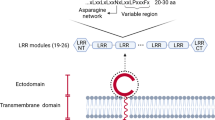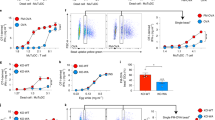Abstract
During pathogen infection, antibodies can be carried into the infected cell, where they are detected by the ubiquitously expressed cytosolic antibody receptor TRIM21. Here we found that recognition of intracellular antibodies by TRIM21 activated immune signaling. TRIM21 catalyzed the formation of Lys63 (K63)-linked ubiquitin chains and stimulated the transcription factor pathways of NF-κB, AP-1, IRF3, IRF5 and IRF7. Activation resulted in the production of proinflammatory cytokines, modulation of natural killer stress ligands and induction of an antiviral state. Intracellular antibody signaling was abrogated by genetic deletion of TRIM21 and was restored by ectopic expression of TRIM21. The sensing of antibodies by TRIM21 was stimulated after infection by DNA or RNA nonenveloped viruses or intracellular bacteria. Thus, the antibody-TRIM21 detection system provides potent, comprehensive activation of the innate immune system independently of known pattern-recognition receptors.
This is a preview of subscription content, access via your institution
Access options
Subscribe to this journal
Receive 12 print issues and online access
$209.00 per year
only $17.42 per issue
Buy this article
- Purchase on Springer Link
- Instant access to full article PDF
Prices may be subject to local taxes which are calculated during checkout








Similar content being viewed by others
References
Akira, S. & Takeda, K. Toll-like receptor signalling. Nat. Rev. Immunol. 4, 499–511 (2004).
Yoneyama, M. et al. The RNA helicase RIG-I has an essential function in double-stranded RNA-induced innate antiviral responses. Nat. Immunol. 5, 730–737 (2004).
Kato, H. et al. Differential roles of MDA5 and RIG-I helicases in the recognition of RNA viruses. Nature 441, 101–105 (2006).
Matzinger, P. Tolerance, danger, and the extended family. Annu. Rev. Immunol. 12, 991–1045 (1994).
Bianchi, M.E. DAMPs, PAMPs and alarmins: all we need to know about danger. J. Leukoc. Biol. 81, 1–5 (2007).
Mallery, D.L. et al. Antibodies mediate intracellular immunity through tripartite motif-containing 21 (TRIM21). Proc. Natl. Acad. Sci. USA 107, 19985–19990 (2010).
James, L.C., Keeble, A.H., Khan, Z., Rhodes, D.A. & Trowsdale, J. Structural basis for PRYSPRY-mediated tripartite motif (TRIM) protein function. Proc. Natl. Acad. Sci. USA 104, 6200–6205 (2007).
Hauler, F., Mallery, D.L., McEwan, W.A., Bidgood, S.R. & James, L.C. AAA ATPase p97/VCP is essential for TRIM21-mediated virus neutralization. Proc. Natl. Acad. Sci. USA 109, 19733–19738 (2012).
McEwan, W.A., Mallery, D.L., Rhodes, D.A., Trowsdale, J. & James, L.C. Intracellular antibody-mediated immunity and the role of TRIM21. Bioessays 33, 803–809 (2011).
McEwan, W.A. et al. Regulation of virus neutralization and the persistent fraction by TRIM21. J. Virol. 86, 8482–8491 (2012).
Stremlau, M. et al. The cytoplasmic body component TRIM5α restricts HIV-1 infection in Old World monkeys. Nature 427, 848–853 (2004).
Pertel, T. et al. TRIM5 is an innate immune sensor for the retrovirus capsid lattice. Nature 472, 361–365 (2011).
Keeble, A.H., Khan, Z., Forster, A. & James, L.C. TRIM21 is an IgG receptor that is structurally, thermodynamically, and kinetically conserved. Proc. Natl. Acad. Sci. USA 105, 6045–6050 (2008).
Wertz, I.E. & Dixit, V.M. Signaling to NF-κB: regulation by ubiquitination. Cold Spring Harb. Perspect. Biol. 2, a003350 (2010).
Xia, Z.P. et al. Direct activation of protein kinases by unanchored polyubiquitin chains. Nature 461, 114–119 (2009).
Ea, C.K., Deng, L., Xia, Z.P., Pineda, G. & Chen, Z.J. Activation of IKK by TNFα requires site-specific ubiquitination of RIP1 and polyubiquitin binding by NEMO. Mol. Cell 22, 245–257 (2006).
Wu, C.J., Conze, D.B., Li, T., Srinivasula, S.M. & Ashwell, J.D. Sensing of Lys 63-linked polyubiquitination by NEMO is a key event in NF-kappaB activation. Nat. Cell Biol. 8, 398–406 (2006).
Yang, K. et al. TRIM21 is essential to sustain IFN regulatory factor 3 activation during antiviral response. J. Immunol. 182, 3782–3792 (2009).
Kong, H.J. et al. Cutting edge: autoantigen Ro52 is an interferon inducible E3 ligase that ubiquitinates IRF-8 and enhances cytokine expression in macrophages. J. Immunol. 179, 26–30 (2007).
Young, J.A. et al. Fas-associated death domain (FADD) and the E3 ubiquitin-protein ligase TRIM21 interact to negatively regulate virus-induced interferon production. J. Biol. Chem. 286, 6521–6531 (2011).
Higgs, R. et al. Self protection from anti-viral responses–Ro52 promotes degradation of the transcription factor IRF7 downstream of the viral Toll-Like receptors. PLoS ONE 5, e11776 (2010).
Higgs, R. et al. The E3 ubiquitin ligase Ro52 negatively regulates IFN-β production post-pathogen recognition by polyubiquitin-mediated degradation of IRF3. J. Immunol. 181, 1780–1786 (2008).
Champsaur, M. & Lanier, L.L. Effect of NKG2D ligand expression on host immune responses. Immunol. Rev. 235, 267–285 (2010).
Ben-Israel, H. & Kleinberger, T. Adenovirus and cell cycle control. Front. Biosci. 7, d1369–d1395 (2002).
Morse, L., Chen, D., Franklin, D., Xiong, Y. & Chen-Kiang, S. Induction of cell cycle arrest and B cell terminal differentiation by CDK inhibitor p18INK4c and IL-6. Immunity 6, 47–56 (1997).
Schreiber, M. et al. Control of cell cycle progression by c-Jun is p53 dependent. Genes Dev. 13, 607–619 (1999).
Liebermann, D.A. & Hoffman, B. Myeloid differentiation (MyD)/growth arrest DNA damage (GADD) genes in tumor suppression, immunity and inflammation. Leukemia 16, 527–541 (2002).
Smith, E.C., Popa, A., Chang, A., Masante, C. & Dutch, R.E. Viral entry mechanisms: the increasing diversity of paramyxovirus entry. FEBS J. 276, 7217–7227 (2009).
Beuzón, C.R., Salcedo, S.P. & Holden, D.W. Growth and killing of a Salmonella enterica serovar Typhimurium sifA mutant strain in the cytosol of different host cell lines. Microbiology 148, 2705–2715 (2002).
Birmingham, C.L. & Brumell, J.H. Autophagy recognizes intracellular Salmonella enterica serovar Typhimurium in damaged vacuoles. Autophagy 2, 156–158 (2006).
Beuzón, C.R. et al. Salmonella maintains the integrity of its intracellular vacuole through the action of SifA. EMBO J. 19, 3235–3249 (2000).
Petrovska, L. et al. Salmonella enterica serovar Typhimurium interaction with dendritic cells: impact of the sifA gene. Cell Microbiol. 6, 1071–1084 (2004).
Schmitz, H., Wigand, R. & Heinrich, W. Worldwide epidemiology of human adenovirus infections. Am. J. Epidemiol. 117, 455–466 (1983).
Yoshimi, R. et al. Gene disruption study reveals a nonredundant role for TRIM21/Ro52 in NF-κB-dependent cytokine expression in fibroblasts. J. Immunol. 182, 7527–7538 (2009).
Fuchs, R. & Blaas, D. Uncoating of human rhinoviruses. Rev. Med. Virol. 20, 281–297 (2010).
Negishi, H. et al. Cross-interference of RLR and TLR signaling pathways modulates antibacterial T cell responses. Nat. Immunol. 13, 659–666 (2012).
Koshiba, R. et al. Regulation of cooperative function of the Il12b enhancer and promoter by the interferon regulatory factors 3 and 5. Biochem. Biophys. Res. Commun. 430, 95–100 (2012).
Chatterji, U. et al. Trim5α accelerates degradation of cytosolic capsid associated with productive HIV-1 entry. J. Biol. Chem. 281, 37025–37033 (2006).
Diaz-Griffero, F. et al. Rapid turnover and polyubiquitylation of the retroviral restriction factor TRIM5. Virology 349, 300–315 (2006).
Barouch, D.H. Novel adenovirus vector-based vaccines for HIV-1. Curr Opin HIV AIDS 5, 386–390 (2010).
Cheng, C. et al. Decreased pre-existing Ad5 capsid and Ad35 neutralizing antibodies increase HIV-1 infection risk in the Step trial independent of vaccination. PLoS ONE 7, e33969 (2012).
Muruve, D.A. The innate immune response to adenovirus vectors. Hum. Gene Ther. 15, 1157–1166 (2004).
Acknowledgements
We thank M. Peeples (Nationwide Children's Hospital) for RSV; and D. Brown (University of Cambridge) for FCV. Supported by the Medical Research Council (U105181010), the European Research Council (281627-IAI) and the Frank Edward Elmore Fund of the University of Cambridge School of Clinical Medicine (J.C.H.T.).
Author information
Authors and Affiliations
Contributions
W.A.M. and L.C.J. initiated the study; W.A.M., J.C.H.T. and L.C.J. wrote the manuscript; and all authors conceived of and did experiments, analyzed data, edited the manuscript and prepared figures.
Corresponding authors
Ethics declarations
Competing interests
The authors declare no competing financial interests.
Supplementary information
Supplementary Text and Figures
Supplementary Figures 1–7 (PDF 2747 kb)
Rights and permissions
About this article
Cite this article
McEwan, W., Tam, J., Watkinson, R. et al. Intracellular antibody-bound pathogens stimulate immune signaling via the Fc receptor TRIM21. Nat Immunol 14, 327–336 (2013). https://doi.org/10.1038/ni.2548
Received:
Accepted:
Published:
Issue Date:
DOI: https://doi.org/10.1038/ni.2548
This article is cited by
-
A TRIM21-based bioPROTAC highlights the therapeutic benefit of HuR degradation
Nature Communications (2023)
-
TRIM21 inhibits irradiation-induced mitochondrial DNA release and impairs antitumour immunity in nasopharyngeal carcinoma tumour models
Nature Communications (2023)
-
Trim-Away ubiquitinates and degrades lysine-less and N-terminally acetylated substrates
Nature Communications (2023)
-
AGO4 suppresses tumor growth by modulating autophagy and apoptosis via enhancing TRIM21-mediated ubiquitination of GRP78 in a p53-independent manner
Oncogene (2023)
-
Mutual regulation between TRIM21 and TRIM8 via K48-linked ubiquitination
Oncogene (2023)



